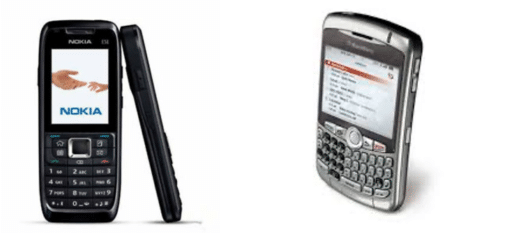Why are foldable and dual screen phones the future?

App development for foldable and dual screen phones is an exciting opportunity. Developers want to explore new territories and set trends rather than follow them. Foldable and dual screen phones are the future and developers should embrace this emerging opportunity. What makes us say so? At Avalon CX, we’ve been building mobile experiences since the previous millennium, which gives us a bit of perspective. Some things are on and off fashion. Then there are more predictable trends. Let’s look at some trends to extrapolate the future of foldable and dual-screen phones.
Smartphone landscape when the iPhone launched
iPhone wasn’t the first smartphone. The first smartphones came with a small display and physical keys. Yet, you could download applications and multitask with them. Top-of-the-line samples from 2007 are the Nokia E51 and Blackberry Curve, each with 2” and 2.5” displays respectively. Back in the day, half of the phone was dedicated to input (keys) and a half to consumption (display.) Industry consensus was that people prefer physical keys and don’t want to smudge the display with fingerprints. We were wrong.
Along came the iPhone which revolutionized the market. The operating system was fresh. An ever growing app ecosystem offered a new wow every day. The display was 2-3x what we were used to having. The price we paid was the lack of tactility. Language evolved to emojis, interaction to taps and swipes, and millennials came with faster thumbs.

The steady growth of the screen size
The first iPhone had a 3.5” screen, already a 3x improvement to the Nokia E51. Today, the largest iPhone 13 variant has a 6.7” screen. Display sizes measure as a diagonal line from corner to corner. So, you could fit three 3.5” original iPhone screens to the 6.7” screen area of the iPhone 13 Pro Max. Put in another way. The display area has grown 17% year-over-year for the past 14 years. (E51 vs. latest iPhone)
Samsung has always approached the market with a broader portfolio than Apple. Galaxy Tab S7 has a 12.4” display, but as the name indicates, this is a tablet with phone capabilities rather than a pocketable phone.
The appetite for bigger screens has taught us to accept less pocketable phone sizes. The trend is clear. Once you try a larger screen, it’s hard to go back. But at some point, we’ll reach the maximum size the mainstream people consider pocketable. What then?
Showing more isn’t a new trend
As an industry, we have innovated a number of ways to present more in a pocketable phone size over the years.
- The displays have gotten better. QVGA was a typical high-end phone resolution in 2007. Currently, new phones have more pixels than the 60” TV in a typical living room and more than enough for our eyes to see. iPhone 13 Max Pro has 50 times more pixels than Nokia E51 from 2007. That represents a 32% average annual increase over 14 years. Display quality has improved in other aspects too.
- The passive areas are the footprint of the phone that’s not an active display. In contrast, the active area is the display’s proportion divided by the footprint.
- The candy bar phones, such as Nokia E51, had an active area of about 25% and Blackberries around 30%.
- The original iPhone raised the bar to 50% active area, and the trend has continued
- iPhone 13 Pro Max has an 87.4% screen-to-body ratio. It’ll surely improve from here but the upside is limited. And if you’re wondering, Galaxy Tab S7, with its massive 12.4 inch display land in the same ballpark with 84.6% ratio.
Improving resolution doesn’t allow squeezing more content on display anymore, as our vision is the limiting factor. Reducing the passive areas has a limited potential too. So, where do we go next?
More display(s) is the answer
Foldable smartphones have existed for a long time. Nokia Communicator E90, incidentally, also launched in 2007 and had two displays and was the status symbol of a successful businessman in many parts of the world. It extended a traditional candy bard form factor with a full keyboard and a big(ger) display. It allowed a quick glance at the information and expanded the view, and took action with more real estate.
Tackling the same challenge in 2021, the leading Android manufacturers are looking into the foldable form factor. Samsung and Microsoft are leading the way and stretching the active display past 150% of the footprint with Surface Duo 2 and Galaxy Fold 3. For us, they are a natural direction for mobile phones:
- They leverage a proven foldable form factor going back decades, and
- They continue the trend of bigger screens and active areas without pushing the footprint out of our pocketable convenience zone.
App development for foldable and dual screen phones is an exciting opportunity, we dare say!

Want to talk more? Contact us.
